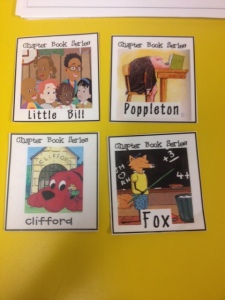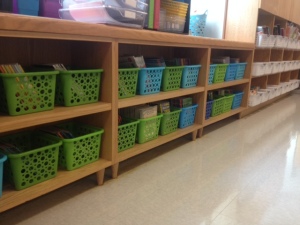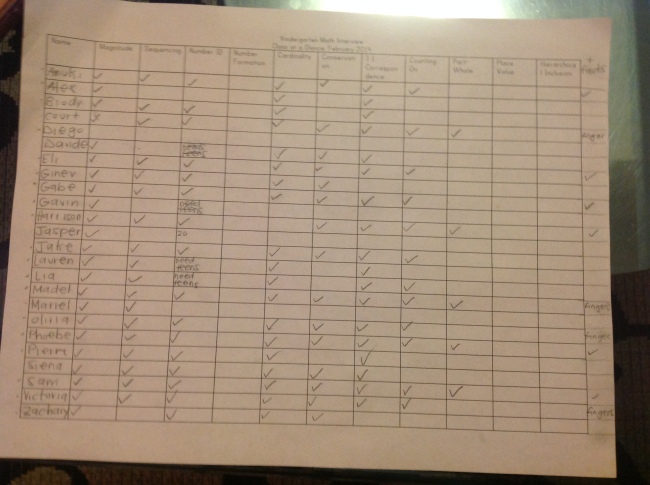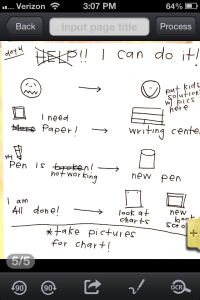isn’t it interesting how making tiny changes can have such a big impact? the dermatologist (and deanna) has always insisted that i drink tons and tons of water. it wasn’t until recently, that i actually got around to doing it (why?!) when i noticed what a major change i saw in my skin. i got to thinking about the way that just a few small changes in classrooms (like in life) can really make a big difference. in the next few days, we’ll share some shifts you may consider making when you start the school year, and we bet you’ll be pleased with the large-scale outcome.
get set-up!
this one’s an oldie but a goodie that i always feel like everyone knows about, but time and time again, teachers confess this *new* little tip changed the entire vibe of the workshop.
here’s the deal: have your kids SET UP for the workshop before they come to the rug. the way this looks varies from classroom to classroom, but the end result is the same: after you name the link of your minilesson, or as i like to say, the little bow on the package of the gift, kids can tiptoe right off to wherever it is that they read or write, and actually start reading and writing.
here’s one possibility of how the set-up time can look:
reading:
- turn your chairs back-to-back the purpose is twofold: kids sit this way so that they’re less distracted at their tables than they would be if they were all facing into the middle AND when it’s partner time, a simple movement to turn chairs side-to-side allows kids to work right away with their partner. (quick tip: remember to have kids sit next to their reading partner at their tables, otherwise this wont work as smoothly!)
- choose one book when kids come back to their table spot to begin reading, the first book they want to read is right there waiting for them, they don’t need to waste any time digging through their book baggies before they get started.
- come to the rug
in writing, you’ll probably try a similar version, having kids take out their writing folders, and choose one “book” (writing piece) from their folders before they come to the rug.
i’m telling you… you will feel a sense of calmness and readiness as kids leave the rug to go off and begin working. and, more importantly, you’ll notice more kids actually trying out the strategies you teach in the minilesson, because there’s no interruption in their brains between the link of the minilesson and when they actually get started working.
in the beginning of the school year, it helps to do a super quick shared reading of the chart you’ve made with the steps to get set-up before the kids actually do it. if you have them do this for a week or two, the kids really internalize the process. remember, too, that you don’t need to keep these charts hanging up all day long (and definitely not all year long). i usually put this up on my easel when we get set up and then put it away since it’s not going to support kids while they’re actually working, and of course, that makes room for other charts they really will use. i’ve also taken a photo and made smaller copies to go in book baggies for kids to read (which they love.)
speed up transitions
with all the transitions in the workshop, teachers are always looking for a way to make kids move more quickly. i’ll tell you what doesn’t work: rushing kids. the more you rush them (“hurry up!” “you’re late to the rug, line, etc.!”) the slower they go. this isn’t rocket science – when we do this, we stress kids out. and what happens when we get stressed? our brains don’t function as efficiently. think of a time you felt a high amount of stress, maybe because you had a bunch of things left on your to-do list for the dinner party you’re hosting, that begins in a few minutes, and oops, you haven’t even showered yet. in every effort to move quickly, you notice you’re actually doing quite the opposite – dropping things, forgetting what else you need to do.
setting up before the workshop will help kids when they are sent off from the minilesson, and even when they transition from independent time to partner time. but what about the end of each workshop, when we invite children to the rug for a closing, or the share? is it just me, or is this the time when i notice a lag in their steps – it’s like there’s less of a sense of urgency here for some reason. BUT the share is another opportunity for teaching, so it’s important to get all the kids to the rug quickly so that they don’t miss out on anything.
i realize there might be a major revolt when i say this, but it makes me a little nuts when i see big timers essentially “rushing” kids to the rug (especially when it means the whole class “gets” something, a point, a smiley, a whatever) if everyone is there on time. i’m not saying there’s never a time and place (pun intended) for timers, but for me, this just isn’t it.
instead, i like to teach kids what the share time is. i often explain in the beginning of the year some of the fun things that happen during the share, and why they’ll want to get back to the rug quickly so they don’t miss it. so, when i stop my readers or writers from their work, and announce that it’s time for the share, kids start moving. here are a few ways you can help to speed it up:
-read a story. this is my favorite option. here, i’m not talking about the interactive read-aloud you’ve planned for the day. i’m talking about reading little leveled books that come straight from your kids book baggies. you know, the ones we want them to love and reread again and again, yet we’ve never bothered actually reading them to the class? here’s the perfect time to squeeze in a quick read aloud of books leveled at A-G, which take no more than 3-4 minutes to read. at the end of the year in kindergarten, i had kids reading on levels D-H that still wanted to shop for books like Worm Builds and BIngo Goes to School. not only will this get kids to fly to the rug because they don’t want to miss the story, but it will also share the message with your children that the books they read are stories we can love just as much as any others.
-play a song. tell children they should be on the rug by time the song is over. be realistic about how much time you give children to clean up. to really put everything away properly and get settled, it probably takes 3-4 minutes. this is less stressful than having this big timer in your face, in my opinion.
–cut some slack. bear in mind, some children might need additional support during transitions. many children who exhibit difficult behaviors tend to experience that difficulty during this less-structured time. this is where individual charts and checklists may come in handy.
hang tight… more management tips heading your way throughout next week. what are your favorite management tips? what part of the workshop would you like us to share some management tips for? let us know! @alyssalnewman @dee4soul




















